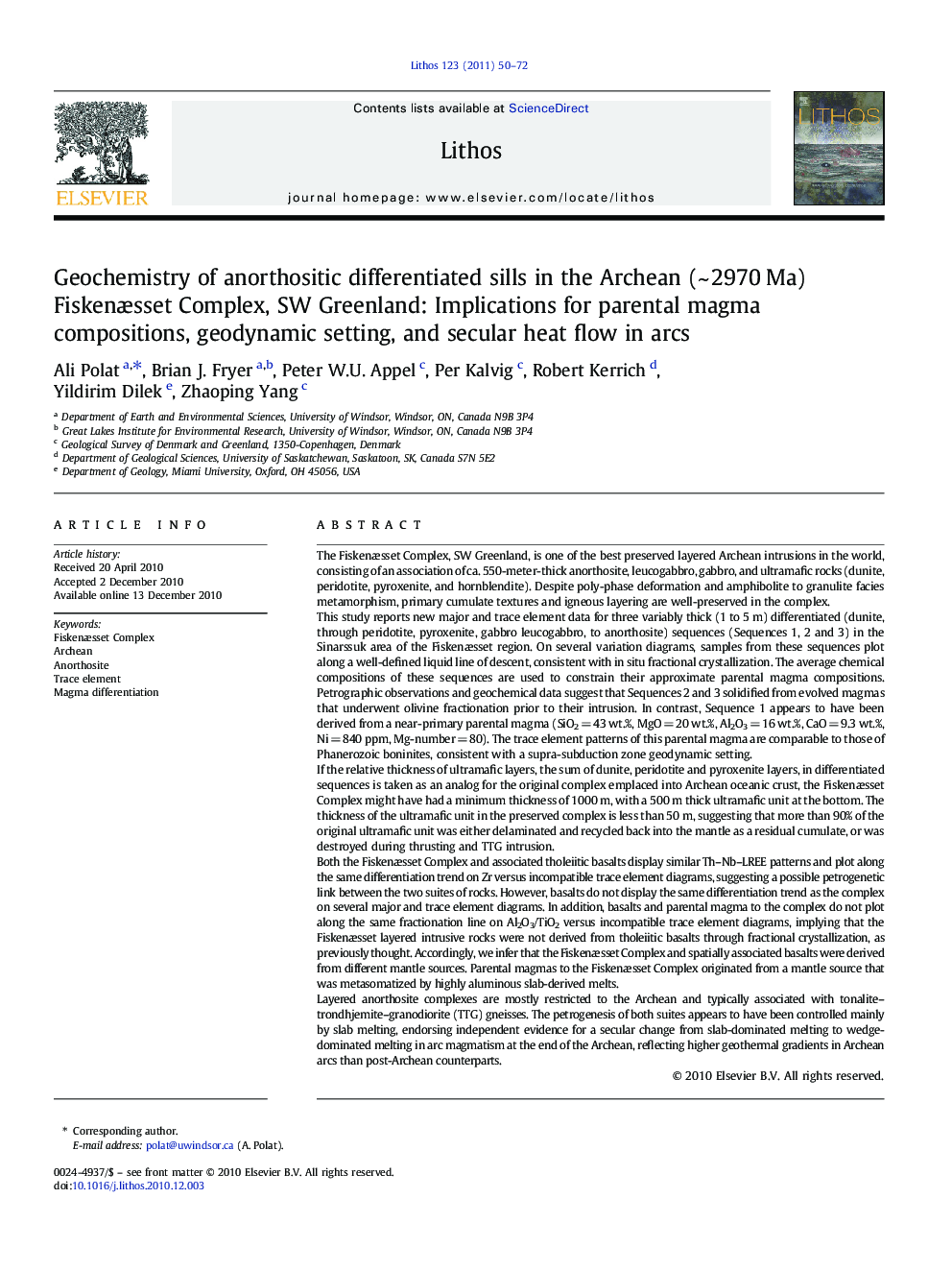| کد مقاله | کد نشریه | سال انتشار | مقاله انگلیسی | نسخه تمام متن |
|---|---|---|---|---|
| 4716786 | 1638722 | 2011 | 23 صفحه PDF | دانلود رایگان |

The Fiskenæsset Complex, SW Greenland, is one of the best preserved layered Archean intrusions in the world, consisting of an association of ca. 550-meter-thick anorthosite, leucogabbro, gabbro, and ultramafic rocks (dunite, peridotite, pyroxenite, and hornblendite). Despite poly-phase deformation and amphibolite to granulite facies metamorphism, primary cumulate textures and igneous layering are well-preserved in the complex.This study reports new major and trace element data for three variably thick (1 to 5 m) differentiated (dunite, through peridotite, pyroxenite, gabbro leucogabbro, to anorthosite) sequences (Sequences 1, 2 and 3) in the Sinarssuk area of the Fiskenæsset region. On several variation diagrams, samples from these sequences plot along a well-defined liquid line of descent, consistent with in situ fractional crystallization. The average chemical compositions of these sequences are used to constrain their approximate parental magma compositions. Petrographic observations and geochemical data suggest that Sequences 2 and 3 solidified from evolved magmas that underwent olivine fractionation prior to their intrusion. In contrast, Sequence 1 appears to have been derived from a near-primary parental magma (SiO2 = 43 wt.%, MgO = 20 wt.%, Al2O3 = 16 wt.%, CaO = 9.3 wt.%, Ni = 840 ppm, Mg-number = 80). The trace element patterns of this parental magma are comparable to those of Phanerozoic boninites, consistent with a supra-subduction zone geodynamic setting.If the relative thickness of ultramafic layers, the sum of dunite, peridotite and pyroxenite layers, in differentiated sequences is taken as an analog for the original complex emplaced into Archean oceanic crust, the Fiskenæsset Complex might have had a minimum thickness of 1000 m, with a 500 m thick ultramafic unit at the bottom. The thickness of the ultramafic unit in the preserved complex is less than 50 m, suggesting that more than 90% of the original ultramafic unit was either delaminated and recycled back into the mantle as a residual cumulate, or was destroyed during thrusting and TTG intrusion.Both the Fiskenæsset Complex and associated tholeiitic basalts display similar Th–Nb–LREE patterns and plot along the same differentiation trend on Zr versus incompatible trace element diagrams, suggesting a possible petrogenetic link between the two suites of rocks. However, basalts do not display the same differentiation trend as the complex on several major and trace element diagrams. In addition, basalts and parental magma to the complex do not plot along the same fractionation line on Al2O3/TiO2 versus incompatible trace element diagrams, implying that the Fiskenæsset layered intrusive rocks were not derived from tholeiitic basalts through fractional crystallization, as previously thought. Accordingly, we infer that the Fiskenæsset Complex and spatially associated basalts were derived from different mantle sources. Parental magmas to the Fiskenæsset Complex originated from a mantle source that was metasomatized by highly aluminous slab-derived melts.Layered anorthosite complexes are mostly restricted to the Archean and typically associated with tonalite–trondhjemite–granodiorite (TTG) gneisses. The petrogenesis of both suites appears to have been controlled mainly by slab melting, endorsing independent evidence for a secular change from slab-dominated melting to wedge-dominated melting in arc magmatism at the end of the Archean, reflecting higher geothermal gradients in Archean arcs than post-Archean counterparts.
Research Highlights
► Mesoarchean Fiskenæsset Complex in SW Greenland was derived from ultramafic parental magmas.
► Mantle source of the complex was enriched by slab-derived aluminous melts.
► The Fiskenæsset rocks originated in a supra-subduction geodynamic setting.
► The Fiskenæsset Complex and associated basalts were derived from different mantle sources.
► Archean arcs appear to have had higher heat flows than Phanerozoic counterparts.
Journal: Lithos - Volume 123, Issues 1–4, April 2011, Pages 50–72